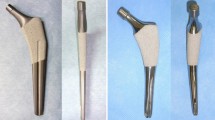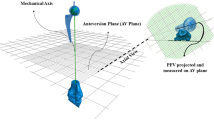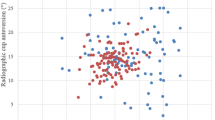Abstract
Purpose
Larger-diameter (≥40 mm) femoral heads decrease the incidence of post-operative dislocation in total hip arthroplasty (THA). This study was conducted to discover whether larger-diameter femoral heads result in greater range of motion of the hip with the use of a computed tomography (CT)-based navigation system.
Methods
Thirty-nine primary THAs were performed via a posterolateral approach using a CT-based navigation system. The stem was inserted in the femur in line with the original femoral neck anteversion. Considering the range of motion during various daily activities which could occur without impingement, the cup anteversion was decided at 10 ° increments according to the stem anteversion. While the cup inclination was set at 40 ° in order to avoid a high inclination angle to prevent the edge roading between the HXLPE liner and ceramic head. After implantation, trial liners and femoral heads were used with either 28 or 40 mm diameter. Maximal hip flexion, extension, abduction, external rotation in extension at 0° and internal rotation angles in flexion at 90 ° were measured. The differences between the ranges of motion with the 40-mm and 28-mm heads were tested. The results were assessed with paired Student t-tests.
Results
The ranges of motion in flexion, extension, abduction and internal rotation angles improved significantly with the 40-mm heads compared with the 28-mm heads. The ranges of motion of cases where maximal flexion angle was 90° or less were excluded, improved significantly with the 40 mm heads.
Conclusions
We concluded that the larger-diameter 40-mm femoral prosthetic heads result in greater ranges of motion in flexion, extension, abduction and internal rotation.





Similar content being viewed by others
References
Bartz RL, Noble PC, Kadakia NR, Tullos HS (2000) The effect of femoral component head size on posterior dislocation of the artificial hip joint. J Bone Joint Surg Am 82:1300–1307
Berry DJ, von Knoch M, Schleck CD, Harmsen WS (2005) Effect of femoral head diameter and operative approach on risk of dislocation after primary total hip arthroplasty. J Bone Joint Surg Am 87:2456–2463
Boyer B, Philippot R, Geringer J, Farizon F (2012) Primary total hip arthroplasty with dual mobility socket to prevent dislocation: a 22-year follow-up of 240 hips. Int Orthop 36:511– 518
Cai P, Hu Y, Xie J (2012) Large-diameter Delta ceramic-on-ceramic versus common-sized ceramic-on-polyethylene bearings in THA. Orthopedics 35:e1307–e1313
Combes A, Migaud H, Girard J, Duhamel A, Fessy MH (2013) Low rate of dislocation of dual-mobility cups in primary total hip arthroplasty. Clin Orthop Relat Res 471:3891–3900
Conroy JL, Whitehouse SL, Graves SE, Pratt NL, Ryan P, Crawford RW (2008) Risk factors for revision for early dislocation in total hip arthroplasty. J Arthroplasty 23:867–872
Crowninshield RD, Maloney WJ, Wentz DH, Humphrey SM, Blanchard CR (2004) Biomechanics of large femoral heads: what they do and don’t do. Clin Orthop Relat Res 429:102–107
Cuckler JM, Moore KD, Lombardi AV Jr, McPherson E, Emerson R (2004) Large versus small femoral heads in metal-on-metal total hip arthroplasty. J Arthroplasty 19:41–44
D’Lima DD, Urquhart AG, Buehler KO, Walker RH, Colwell CW (2000) The effect of the orientation of the acetabular and femoral components on the range of motion of the hip at different headneck ratios. J Bone Joint Surg Am 82:315–321
Garbuz DS, Masri BA, Duncan CP, Greidanus NV, Bohm ER, Petrak MJ, Della Valle CJ, Gross AE (2012) The Frank Stinchfield award: dislocation in revision THA: do large heads (36 and 40 mm) result in reduced dislocation rates in a randomized clinical trial? Clin Orthop Relat Res 470:351–356
Guyen O, Pibarot V, Vaz G, Chevillotte C, Béjui-Hugues J (2009) Use of a dual mobility socket to manage total hip arthroplasty instability. Clin Orthop Relat Res 467:465–472
Hamadouche M, Arnould H, Bouxin B (2012) Is a cementless dual mobility socket in primary THA a reasonable option? Clin Orthop Relat Res 470:3048–3053
Hedlundh U, Fredin H (1995) Patient characteristics in dislocations after primary total hip arthroplasty: 60 patients compared with a control group. Acta Orthop Scand 66:225–228
Hermida JC, Bergula A, Chen P, Colwell CW Jr, D’Lima DD (2003) Comparison of the wear rates of twenty-eight and thirty-two-millimeter femoral heads on cross-linked polyethylene acetabular cups in a wear simulator. J Bone Joint Surg Am 85:2325–2331
He RX, Yan SG, Wu LD, Wang XH, Dai XS (2007) Position of the prosthesis and the incidence of dislocation following total hip replacement. Chin Med J (Engl) 120:1140–1144
Hirata M, Nakashima Y, Hara D, Kanazawa M, Kohno Y, Yoshimoto K, Iwamoto Y (2015) Optimal anterior femoral offset for functional range of motion in total hip arthroplasty—a computer simulation study. Int Orthop 39:645–651
Howie DW, Holubowycz OT, Middleton R (2012) Large femoral heads decrease the incidence of dislocation after total hip arthroplasty: a randomized controlled trial. J Bone Joint Surg Am 94:1095–1102
Jacobs JJ (2012) Large (36 or 40-mm) femoral heads decreased the rate of dislocation after revision total hip arthroplasty. J Bone Joint Surg Am 94:2095
Katz JN, Losina E, Barrett J, Phillips CB, Mohamed NN, Lew RA, Guadagnoli E, Harris WH, Poss R, Baron JA (2001) Association between hospital and surgeon procedure volume and outcomes of total hip replacement in the United States Medicare population. J Bone Joint Surg Am 83:1622–1629
Khatod M, Barber T, Paxton E, Namba R, Fithian D (2006) An analysis of the risk of hip dislocation with a contemporary total joint registry. Clin Orthop Relat Res 447:19–23
Lavigne M, Ganapathi M, Mottard S, Girard J, Vendittoli PA (2011) Range of motion of large head total hip arthroplasty is greater than 28 mm total hip arthroplasty or hip resurfacing. Clin Biomech 26:267–273
Lombardi AV Jr, Skeels MD, Berend KR, Adams JB, Franchi OJ (2011) Do large heads enhance stability and restore native anatomy in primary total hip arthroplasty? Clin Orthop Relat Res 469:1547–1553
Mallory TH, Lombardi AV Jr, Fada RA, Herrington SM, Eberle RW (1999) Dislocation after total hip arthroplasty using the anterolateral abductor split approach. Clin Orthop Relat Res 358:166–172
Massin P, Orain V, Philippot R, Farizon F, Fessy MH (2012) Fixation failures of dual mobility cups: a mid-term study of 2601 hip replacements. Clin Orthop Relat Res 470:1932–1940
Matsushita A, Nakashima Y, Jingushi S, Yamamoto T, Kuraoka A, Iwamoto Y (2009) Effects of the femoral offset and the head size on the safe range of motion in total hip arthroplasty. J Arthroplasty 24:646–651
Meek RMD, Allan DB, McPhillips G, Kerr L, Howie CR (2006) Epidemiology of dislocation after total hip arthroplasty. Clin Orthop Relat Res 447:9–18
Miki H, Yamanashi W, Nishii T, Sato Y, Yoshikawa H, Sugano N (2007) Anatomic hip range of motion after implantation during total hip arthroplasty as measured by a navigation system. J Arthroplasty 22:946–952
Muratoglu OK, Bragdon CR, O’Connor D, Perinchief RS, Estok DM 2nd, Jasty M, Harris WH (2001) Larger diameter femoral heads used in conjunction with a highly crosslinked ultra-high molecular weight polyethylene: a new concept. J Arthroplasty 16:24–30
Müller M, Duda G, Perka C, Tohtz S (2015) The sagittal stem alignment and the stem version clearly influence the impingement-free range of motion in total hip arthroplasty: a computer model-based analysis. Int Orthop. doi:10.1007/s00264-015-2845-0
Paterno SA, Lachiewicz PF, Kelley SS (1997) The influence of patient related factors and the position of the acetabular component on the rate of dislocation after total hip replacement. J Bone Joint Surg Am 79:1202–1210
Peters CL, McPherson E, Jackson JD, Erickson JA (2007) Reduction in early dislocation rate with large-diameter femoral heads in primary total hip arthroplasty. J Arthroplasty 22:140–144
Philippot R, Boyer B, Farizon F (2013) Intraprosthetic dislocation: a specific complication of the dual-mobility system. Clin Orthop Relat Res 471:965–970
Philippot R, Camilleri JP, Boyer B, Adam P, Farizon F (2009) The use of a dual-articulation acetabular cup system to prevent dislocation after primary total hip arthroplasty: analysis of 384 cases at a mean follow-up of 15 years. Int Orthop 33:927–932
Philips CB, Barrett JA, Losina E, Mohamed NN, Lingard EA, Guadagnoli E, Baron JA, Harris WH, Katz JN (2003) Incidence rates of dislocation, pulmonary embolism, and deep infection during the first six months after elective total hip replacement. J Bone Joint Surg Am 85:20–26
Sariali E, Lazennec JY, Khiami F, Catonné Y (2009) Mathematical evaluation of jumping distance in total hip arthroplasty: influence of abduction angle, femoral head offset, and head diameter. Acta Orthop 80:277–282
Scifert CF, Brown TD, Pedersen DR, Callaghan JJ (1998) A finite element analysis of factors influencing total hip dislocation. Clin Orthop Relat Res 355:152–162
Shoji T, Yamasaki T, Izumi S, Hachisuka S, Ochi M (2015) The influence of stem offset and neck shaft angles on the range of motion in total hip arthroplasty. Int Orthop
Smith TM, Berend KR, Lombardi AV Jr, Emerson RH Jr, Mallory TH (2005) Metal-on metal total hip arthroplasty with large heads may prevent early dislocation. Clin Orthop Relat Res 441:137–142
Stuchin SA (2008) Anatomic diameter femoral heads in total hip arthroplasty: a preliminary report. J Bone Joint Surg Am 90(Suppl 3):52–56
Sugano N, Nishii T, Miki H, Yoshikawa H, Sato Y, Tamura S (2007) Mid-term results of cementless total hip replacement using a ceramic-on-ceramic bearing with and without computer navigation. J Bone Joint Surg (Br) 89:455–460
Tsai TY, Dimitriou D, Li G, Kwon YM (2014) Does total hip arthroplasty restore native hip anatomy? three-dimensional reconstruction analysis. Int Orthop 38:1577–1583
Widmer KH, Zurfluh B (2004) Compliant positioning of total hip components for optimal range of motion. J Orthop Res 22:815–821
Woolson ST, Rahimtoola ZO (1999) Risk factors for dislocation during the first 3 months after primary total hip replacement. J Arthroplasty 14:662–668
Wroblewski BM, Siney PD, Fleming PA (2009) Effect of reduced diameter neck stem on incidence of radiographic cup loosening and revisions in Charnley low-frictional torque arthroplasty. J Arthroplasty 24:10–14
Acknowledgments
We thank the following for their help with reviewing medical records and statistical analysis: Y. Horita, Y. Inatsugu, H. Tsuji, N. Okada, T. Sasai, Y. Uchida, and R.M. Gerling. We also appreciate M. Koshide’s kind offer to draw up the schemes.
Author information
Authors and Affiliations
Corresponding author
Ethics declarations
Conflict of interest
Each author certifies that he or she has no commercial associations (e.g., consultancies, stock ownership, equity interest, patent/licensing arrangements, etc.) that might pose a conflict of interest in connection with the submitted article.
Rights and permissions
About this article
Cite this article
Tsuda, K., Haraguchi, K., Koyanagi, J. et al. A forty millimetre head significantly improves range of motion compared with a twenty eight millimetre head in total hip arthroplasty using a computed tomography-based navigation system. International Orthopaedics (SICOT) 40, 2031–2039 (2016). https://doi.org/10.1007/s00264-015-3095-x
Received:
Accepted:
Published:
Issue Date:
DOI: https://doi.org/10.1007/s00264-015-3095-x




